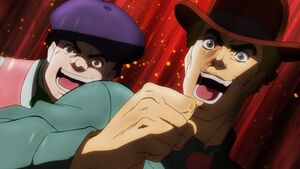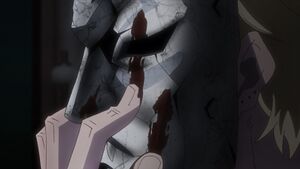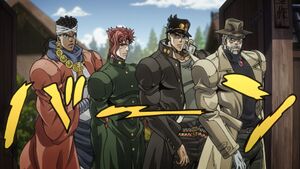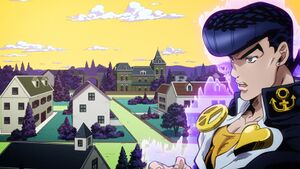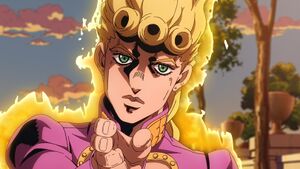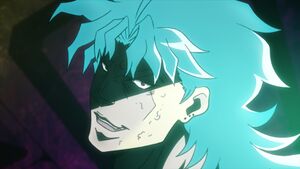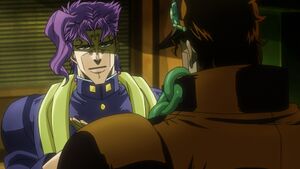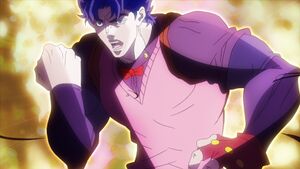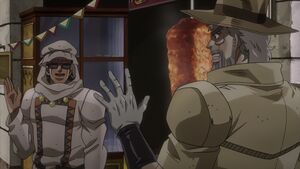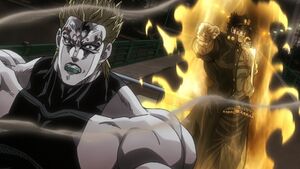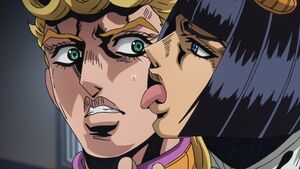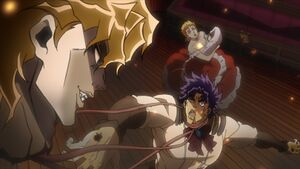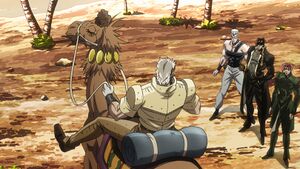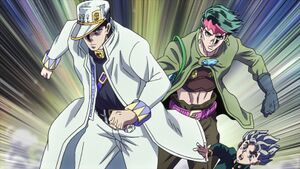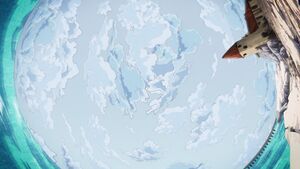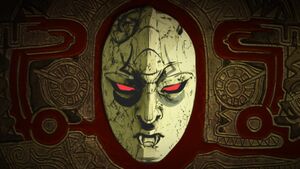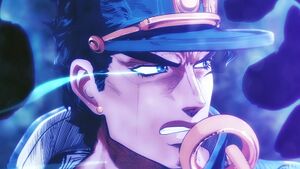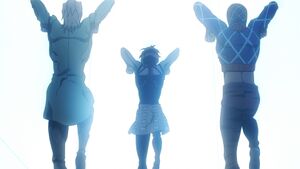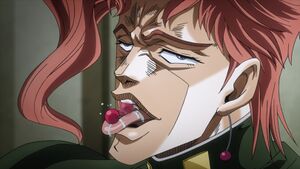Vol. 1
Confronting the talent of Hirohiko Araki as a team! The creators who ran through the JoJo anime
The anime adaptation started with “This is a difficult task”
When he was approached by an anime-related company about making a TV anime, Hiroyuki Omori, a producer at Warner Brothers Japan, was worried for a while that, “This is a difficult task.” Although JoJo is one of the biggest series in Japan, the original manga started in 1987. In the early days, Hirohiko Araki drew characters in a gekiga style that was full of machismo. It was very different from modern trends in character design. Omori wondered if people who weren’t familiar with JoJo would be able to accept these designs. However, he decided to go ahead with the anime adaptation. He says, “There was the problem of what to do with the design, but the power of the work itself has not faded, and above all, I am a big JoJo fan myself, so I decided to take on the challenge despite the difficulties.” After getting Shueisha’s consent, he immediately started to choose a studio.
Naturally, a studio that could draw JoJo would have to be one that “could draw powerful muscle movements.” Therefore, Omori turned his attention to David Production, which was descended from Gonzo, a studio that had created numerous works in the past. At the time, David Production was still a newly established studio, but their work on the anime for the “Tatakau Shisho” series, which is also a JUMP property like JoJo, showed powerful linework and careful animation. Omori was convinced, “I can let them handle this,” and approached them.
Challenging Hirohiko Araki’s talent as a production team
When David Production’s producer Hisataka Kasama received news of the anime adaptation, he came up with the secret plan of having multiple directors. “To be honest, I thought it would be difficult for a single director to take on Araki’s extraordinary talent, so I decided to have more than one director, which is unusual for a TV animation project, and challenge him as a team.”(Kasama) The task fell to Naokatsu Tsuda and Kenichi Suzuki. Although there is a slight difference in the way they are credited, with Tsuda serving as “director” and Suzuki as “series director,” they essentially collaborated on all aspects of the production.
Kasama explained why he chose Tsuda and Suzuki: “Tsuda is a good comedic director, and Suzuki is a good action director. I thought that by working together, we would be able to capture both the strength and the fun of the original manga.” In fact, Tsuda also said, “I’m a JoJo fan myself, but if I had been asked to make the anime by myself, I might have refused. But since I was working with Mr. Suzuki, I thought we might be able to do it. When I think about it now, it’s more like the folly of youthful passion. I wasn’t afraid of anything (laughs).” On the other hand, Suzuki said, “I didn’t feel any particular pressure, and the joy of being involved with JoJo, which I love, was greater than anything else. It’s a big title, but rather than be controlled by the opinions of the people around us, we were going to make our own JoJo.”
The core members of the team were Omori and Kasama, the producers, and Tsuda and Suzuki, the directors. Coincidentally, all four were huge JoJo fans. The respect for the original manga that can be felt from every corner of the film is perhaps a natural result of this lineup. Yasuko Kobayashi joined as series composer at the recommendation of the editorial department, and then, with the further addition of Yasufumi Soejima as visual director, the JoJo anime was finally ready to get going.
Make it “JoJo” not “JoJo-like”
The first aim that Producer Omori discussed with the production team was to “make JoJo.” Not something “JoJo-like” or “JoJo-style,” but JoJo itself. Tsuda and his team read the original manga again and again until their copies were worn out, writing as many elements and characteristics of JoJo as they could think of on the whiteboard. They came up with everything from easy to understand things like “onomatopoeia” and “unique posing” to impressions like “I feel refreshed after reading” and “the battles are difficult.” At the end of the process, they sorted through all of it, and Kasama concluded, “If we follow the usual methods of creating animation, we’ll end up with ‘JoJo’s Ordinary Adventure.’ JoJo has to be a ‘bizarre adventure.’ If you think about it, the answer was in the title from the very beginning.”
In this way, everyone agreed to pursue the complete reproduction of all elements, including the onomatopoeia. The rules established through this meeting were later distributed to all the staff involved in the JoJo anime, and became a sort of “bible” for the rest of the series.
Hook the viewers in the first three episodes!
When the JoJo anime first began, there was no guarantee that it would have four seasons produced. If the first season did not achieve a certain level of success, there would be no second season, so the producer Omori focused especially hard on the first three episodes.
JoJo has a strong image of “stand battles,” and the third part of the original manga, “Stardust Crusaders,” in which stands were introduced, won many fans. For this reason, the question of how to deal with the first part of the original manga, “Phantom Blood,” which tends to be considered simple, was a major issue. Because of this, Omori tried to immerse the viewers in the world of JoJo, and so the animation staff depicted everything up to the first climax in chapter 17 in those first three episodes. Usually, one episode of an anime is equivalent to three or four chapters of a manga, so you can see how drastic the structure was. According to Omori, “I wanted to get the audience hooked on the story by making it a roller coaster ride.”
This strategy proved successful, and it was received favorably by many fans. Omori, who had been following the reactions on social media in real time, recalls, “I was really relieved, thinking we might be okay for a while.”
Raising the quality with the strongest team for the popular “Stardust Crusaders”! With the popularity of the first season, the production team moved on to producing the second season, “Stardust Crusaders,” (Part 3 of the original manga) as soon as the broadcast ended. The biggest draw of the second season is the depiction of fierce battles between the stands, and it is one of the most popular and vital parts of the series. For this reason, the number of drawings was increased compared to the first season, and a new action director was brought in to improve the animation. In terms of direction, Toshiyuki Kato, who played a central role in the first season, was appointed as the new chief director, establishing a more stable direction system.
The 48 episodes, the longest of the four seasons, were completed with consistent quality from start to finish, and the “dynamic beauty of muscles” that the team had been seeking since the first season matured into a completed form.
These silhouettes are familiar to many JoJo fans.
The third season “Diamond is Unbreakable” (Part 4 of the original manga) is a unique work and a complete change of direction
In a change from the second season, which was a road movie, travelling all the way to Egypt from Japan, the third season is set in a small town called Morioh. Kato, who replaced Suzuki after he left JoJo to direct another film, held another brainstorming session with the team in order to accurately understand the style, which was different from anything else in the series up to this point.
“Up until the third part, the purpose of the story was clear, but in the fourth part, it was difficult to know where the goal was. In that sense, it’s quite unique, so we had a thorough discussion about the direction we would go with it.”(Kato)
As a result, they took various creative measures, such as inserting a bizarre scene of the last boss, Kira Yoshikage, at the beginning of the season, and they boldly reconstructed the original manga without losing the charm of the story.
With a new director, the series evolves even further in the fourth season, “Golden Wind” (Part 5 of the original manga)
Kato, who directed the third season, left the JoJo anime to direct another project. With the loss of both Suzuki and Kato, who had been the core of the JoJo series since the first season, Tsuda used his connections to find new talent and persuaded Yasuhiro Kimura and Hideya Takahashi to become the new directors. Tsuda firmly stated, “My greatest achievement in Part 5 was bringing in Mr. Kimura and Mr. Takahashi as the directors and Takahiro Kishida as character designer.”
The two new directors had no experience with the JoJo anime, but they were each able to make full use of their talents. “At first I was worried about whether I could draw JoJo storyboards, but it turned out that I had more freedom than I thought, and I was able to work freely.” (Kimura) “Mr. Kimura and I have very different personalities, and I think we ended up with a series where our personalities really came out.” (Takahashi)
Tsuda’s theme for the fourth season was “Renaissance (Return to the Origin),” a reference to Italy where the story is set. His goal was successfully achieved as both directors went back to the roots of the JoJo anime, and the meticulous location scouting in Italy also brought a new wind to the series. This season is the culmination of Tsuda’s work on the JoJo anime, and currently its highest achievement.
What is the “inherited golden soul” of the JoJo anime?
The JoJo anime adapted an epic drama spanning 63 volumes of manga into a total of 152 episodes over a period of about 7 years. While some staff members have been involved in all parts of the series, including director Naokatsu Tsuda, series composer Yasuko Kobayashi, and sound director Miwa Iwanami, there are many staff members who have left the production or joined along the way. While the JoJo anime has a “bible” that it follows, the visual concept is renewed with every season. The production team that continues to renew itself and move forward is just like the “inherited golden soul.” We hope that it will continue to evolve and be passed on to new generations.
Interviewing and writing by Daisuke Okamoto
Vol.2 An in-depth analysis of “What is ‘JoJo’?” What are the thoughts behind the complete re-creation of the anime? Recreating the original manga with the concept of “Study JoJo scientifically” The request from producer Hiroyuki Omori of Warner Brothers Japan for the production of the JoJo anime was very simple: “Make JoJo.” In response, the director, Naokatsu Tsuda, came up with the slogan, “Study JoJo scientifically.”
He picked out all the elements that made the original JoJo manga unique and searched for ways to reproduce them in animation. He thoroughly recreated unique onomatopoeic sounds such as “Memetaa” and “Gogogogo,” as well as the unique poses, and theatrical dialogue such as “I’m impressed by that! I admire you!” On top of these, he also replicated the use of motion lines and frame layout direction in the animation.
Toshiyuki Kato, who has been directing since the first season, said, “In order to create an eerie atmosphere, there are many depictions of fog, smoke, and other unidentifiable gases swirling around in the original manga. Normally, this would have been done with CG, but we recreated it by hand, just like the original manga. In addition, when we wanted to express the disturbance of the characters, we used suspenseful techniques such as darkening the entire face with tones and illuminating only the eyes, just as in the original manga.” The staff’s attention to detail can be seen everywhere.
The “special scene coloring” is the best part of the anime One notable visual effect is a color expression called “special scene coloring” or “special cut coloring.” As JoJo fans know, there is no fixed color scheme for JoJo. It is quite common for the same character in a color manuscript drawn by Hirohiko Araki to change color drastically from one time to the next, and the fact that he is not bound by a set color scheme is one of the things that makes him unique.
However, unlike manga manuscripts, which are usually drawn in black and white, animation is always in full color. It is not possible to change the colors with every scene. Therefore, Tsuda and his team decided on a basic color scheme that would serve as the overall base, and then adopted “special scene coloring” and “special cut coloring” to change the colors based on developments in the story. These colors are used when the character’s emotions are greatly shaken, or when the story reaches a climax, and they function effectively as accents. It is a concept that takes full advantage of the characteristics of animation, and was retained as a major strength until the fourth season.
Character designs that seek the median of fan’s imagination The character design was a particular point of trial and error in the visual construction of the first season. The characters drawn by Hirohiko Araki in the early days were all muscular and had a drawing style similar to gekiga. It is hard to say that this is in line with modern trends, so the challenge was how to bridge this gap. The production team created character designs that were closer to the mental image of the fans by finding the median value of the character designs from the third to fifth parts of the original manga, since those are the character designs that most JoJo fans imagine, and then bringing that back to the first season. The characters created in this way are generally mild and casual, while retaining the strong atmosphere of the early Araki characters.
From the 19th century to the present day! Art in Transition As the era and setting of the JoJo series changes drastically from one part to the next, the art and setting work took a lot of effort. The first season, “Phantom Blood,” is set in England at the end of the 19th century, and “Battle Tendency” is set in America and Europe before World War II. These were not depicted in a realistic way in the original manga, so in a sense they were depicted as fantasy in the anime as well. The second season, “Stardust Crusaders,” however, takes place in the 1980s in various countries and regions from Japan to Egypt. Not only the architecture, but also the ethnicity and clothing of the people who come and go are diverse, so the burden on the art team, as well as the sub-character designers, was considerable.
The team was also particular about props. For example, Suzuki, who was in charge of the script and storyboard for episodes 37-38 “The Guardian of Hell, Pet Shop,” speculated that the Porsche model in the original manga might be a limited production model commonly known as the Yellow Bird, and he incorporated that into the settings. “The enemy stand at this time was a bird, and a Porsche was running into it, so I thought that perhaps Mr. Araki had a Yellow Bird in mind at the time. Well, I’m completely imagining it (laughs).” (Suzuki) Honestly, there was no need to think so hard about a car that only appeared in a few panels in the original manga, but that is the attention to detail that love for JoJo can create.
The third season, “Diamond is Unbreakable,” is a complete change from previous seasons, and is set in the fictional town of Morioh from start to finish. Kato, the director, created a precise map of the town based on the original manga, and calculated the route to each character’s house and school, as well as the time required to get there. “I think Morioh Town is the other main character of Part 4, so I wanted to make it feel as real as possible. I spent a lot of time creating the town in order to emphasize the contrast between the scenery of rural Japan that everyone is familiar with and the heinous murders that are happening behind the scenes.” (Kato)
The fourth season, “Golden Wind,” is set in Italy in 2001. General director Tsuda and directors Yasuhiro Kimura and Hideya Takahashi traveled to Italy in July 2017 for location scouting. Kimura said, “Our goal from the beginning was to make it easy for viewers to make a pilgrimage to the holy places,” and true to his word, the fans managed to find most of the places that appear in the series. The results of this meticulous location scouting work are captured in the film, giving viewers the feeling of having traveled all over Italy with Giorno and his friends.
The establishment of “JoJo-ism” in drawing When producer Hisataka Kasama of David Production first heard about the JoJo anime project, he worried, “How many animators will be able to work with this design?” It was a big challenge for the studio. Although David Production is a studio that excels at creating strong images, they had never created a work with such a clear emphasis on muscles and skeletons. Kenichi Suzuki, who served as the series director for the first season, looking back on the situation at that time, said, “When it comes to the drawings, I had a clear image of the finished work from the beginning, but in reality, I had to get used to it as I drew it.”
Kato also said that he paid particular attention to the sense of weight in the drawing work in the beginning. “In the rugby scene in the second episode, there is a scene where Jonathan drags three players along but does not stop moving forward, which is intended to give the impression that Jonathan has grown into a powerful young man. However, Jonathan is only human and his physical strength is fundamentally different from that of Dio, who later becomes a vampire and transcends humanity. In other words, it is necessary to show the limits of humanity at the same time, and in order to do so, it had to express the weight of carrying three men on his back. The ‘swell’ created by the high load being applied to various parts of his body is very important, and I remember giving very detailed instructions on how to fix it.” (Kato)
In this way, by carefully communicating the concept for each shot, the know-how gradually accumulated, and the drawing gradually stabilized. Animator Shunichi Ishimoto has been in charge of drawing since the first season. “The JoJo series is basically characterized by dense drawings, so at first we were just drawing through trial and error, but soon there was a ‘battle of density’ among the drawing team,” he says of the drawing situation at the time.
Character acting is similar to “stage” acting?! The acting for the characters in JoJo is not necessarily bound by common sense. In our daily lives, we don’t have the chance to pose in a unique way, nor do we have the chance to say lines like, “Do you remember how much bread you have eaten in your life?”
So the character acting in JoJo is more like theater. Suzuki says, “While there are rules regarding the placement of characters on stage and light sources, we sometimes deviate from them in order to maximize the appeal of Mr. Araki’s best panels. Suddenly, the lighting is changed, or a character is put in the spotlight. It’s like ‘Mie’ in Kabuki.” Kato refers to this as “stage acting,” and it is clear that they share the same image, even if the words are different.
On the other hand, Tsuda describes the battles in JoJo as “professional wrestling.” “In fact, JoJo’s characters are rarely worried. When professional wrestlers get into the ring, they don’t worry about why they’re fighting. They just do their best to make it fun and easy to understand for the audience with their microphone performance and exaggerated gestures. It’s the same with JoJo’s battles. By presenting what you’re going to do and then how it turned out, it makes the battles more interesting. If we prioritize the anime’s sense of showiness and speed, we’ll lose the charm of JoJo’s battles. That’s why I compared it to professional wrestling.” (Tsuda)
In Tsuda’s analysis, the real pleasure of JoJo’s battles is the groove that is created when the tempo and rhythm of long spoken lines, as well as the action, and characterization all come together, and that is what the anime is based on.
Interviewing and writing by Daisuke Okamoto
Vol.3 Balancing a high level of both speed and emotion Demystifying the well-crafted composition and direction! Clearly define the theme for each episode The most important thing to keep in mind when working on the scenario was to make it clear what each story was about. Once the theme of each episode was clear, that would inevitably determine how it should be directed. The line producer, Hisataka Kasama, made the assignments according to the aim of each episode, keeping the individuality of the director in mind rather than just rotating through them. Naokatsu Tsuda was for comedy and daily life, Kenichi Suzuki for action, and Toshiyuki Kato for highly dramatic episodes. On the other hand, the directors had various thoughts and feelings about the masterpiece of JoJo.
“Since we were entrusted with the original manga, we couldn’t just twist it to suit our own needs, so we wanted to somehow re-experience Mr. Araki’s ideas. The book ‘Hirohiko Araki’s Strange Theory of Horror Movies’ (Shueisha Shinsho), which was published right around the time of pre-production, was very useful. I was able to understand that this episode was based on this movie, and that this is what he wanted to do, and I feel like I was able to better determine the direction of the animation.” (Naokatsu Tsuda)
“I tried to trace what Mr. Araki was thinking at the time of writing. Through the movies he was watching and the music he was listening to at the time, I was able to trace his thoughts in my own way. The finished product was already out in the world in the form of manga, but my biggest mission in expressing JoJo was to feel the feelings behind it.” (Kenichi Suzuki)
“The original manga is very powerful, so I wanted to make the most of that to the degree that I could. Personally, I was moved by the scene in Part 4 where Hayato Kawajiri wishes, ‘God, please let me kill people.’ I felt that there was no other shonen manga that could make an elementary school student say such a thing, and I definitely wanted to direct that scene myself.” (Toshiaki Kato)
“I joined the project starting with Part 5, and at first I was a bit confused about how much I should try to match the way things had been expressed before, but once I started working on it, I realized how free I was. It made me realize all over again that JoJo is a work with great capacity.” (Yasuhiro Kimura)
“The main theme of Part 5 is how young people living in despair should go on living, so I was always conscious of the keyword ‘sadness.’ I tried to bring out the mature side in my own way.” (Hideya Takahashi)
The first season is a roller coaster that turns into a water slide?! Initially, the production team wanted the first part of the original manga, “Phantom Blood,” to run for one season and the second part, “Battle Tendency,” to run for two seasons. However, the producer, Hiroyuki Omori, requested that the series be broadcasted in two seasons together. The final result was 26 episodes instead of 24, which was a rather drastic strategy. Omori said, “I thought that by seamlessly broadcasting the first and second parts all at once, people would feel the impact. They thought they were on a roller coaster, but before they knew it, they were on a water slide (laughs).” For “Phantom Blood,” in particular, the 44 chapters of the original manga were turned into 9 episodes of anime, which means that each episode of the anime contains almost 5 chapters of the original manga.
What is noteworthy is that despite running through the story at such speed, almost no stories were omitted. This can be said to be the result of the efforts of the writers, led by Yasuko Kobayashi, who worked on the series composition. In any case, it is this sense of speed that attracted many viewers and opened the door for the production of the next part.
The addition of original scenes increased the road movie feel in the second season, “Stardust Crusaders” In contrast to the first season, which emphasized speed, the second season, “Stardust Crusaders,” was able to have a much more relaxed structure, which allowed the audience to fully enjoy the powerful stand battles unique to the third part of the original manga. The scenario as a whole reproduces the original manga at a very high level, but there are also many scenes that are original to the anime, which increases the “road movie” feel of the journey to Egypt.
In particular, in episode 25, “Iggy the Fool and Geb’s N’Dour, Part 1,” a scene has been added where all six members of the Joestar group take a group photo. This photo was displayed on Jotaro’s desk in the fifth part of the original manga, but it was not clear when it was taken. Tsuda said, “This was the only timing I could think of, so I consulted with Mr. Suzuki, who was in charge of the storyboard and direction, and he put it in.”
Speaking of original scenes, episode 18, “The Sun,” is also impressive. In the original manga, it is a comedy episode that ends after only two chapters, but in the anime, it was composed as one episode. As a result, more than half of the scenes are original scenes, and Tsuda, who worked on the scenario and storyboard, was able to demonstrate his impressive sense for comedy in this episode.
The composition shines best in the third season, “Diamond is Unbreakable” The third season, “Diamond is Unbreakable,” (Part 4 of the original manga) has the most dynamic structure in the anime series, which is clearly shown from the beginning of the first episode, “Jotaro Kujo! Meets Josuke Higashikata.” The horror of a murderer’s crazy breakfast scene is shown against the background of the cheerful MC of Morioh Radio. It suggests the existence of the last boss, Yoshikage Kira, who only appears in the latter half of the story in the original manga, while also beautifully expressing the theme of the fourth part of the original manga, which is abnormal scenes hidden in the shadow of peaceful everyday life. It is an excellent restructuring of the original story.
Kato, who served as the series director for the third season, said, “Unlike the previous stories, the fourth part does not end with the main character directly defeating the last boss, but with all the characters working together to defeat him, or more specifically, the town of Morioh town itself is structured to bury the murderer, Yoshikage Kira. In order to achieve a suitable ending, we had to pay attention to the atmosphere of the town and the depiction of the residents.” Tsuda also said, “I think the fourth part of the series was the most successful in terms of composition. We knew from the beginning that Kira Yoshikage was the final boss, and the whole story takes place in one town, so we were able to use him to our advantage.” From the frequent use of Morioh Radio to the cameo appearances of characters who appear in the latter half of the season, this was a season in which the exquisite composition was on full display.
The fourth season, “Golden Wind,” is full of original scenes that tickle the fan mentality The most significant aspect of the fourth season, “Golden Wind,” (Part 5 of the original manga) is that it emphasizes the team battle more than the original manga. In the original manga, the names and appearances of the members of the assassin team are revealed in the order in which they appear as assassins, but in the anime, the faces of the entire assassin team are revealed in episode 10, “Hitman Team.” Furthermore, by depicting them eating at a restaurant, it is clear that they are also working as a team, just like Giorno and the others. As the assassin team is very popular among the fans of the original manga, the addition of many original scenes is a great service to the fans, and at the same time, it is effective in clearly showing the three-way battle of the fourth season. On the other side, moving up Mista and Abacchio’s past episodes and adding a past episode for Fugo allowed Giorno’s side to feel a sense of unity as a team early on.
Kimura, who served as the director of the 4th season, commented on this point: “The assassin team is very popular among the fans of the original manga, and they are very attractive because they are determined people. They are not attacking on their own, so I hoped that by portraying them as a team, I could convey their conviction.”
In episode 28 “Beneath a Sky on the Verge of Falling,” one of the most famous scenes in the series, Narancia is distraught over the death of Abacchio, and the entire B part of the episode is used to recreate the scene in a way that greatly expands on the original manga. Director Takahashi, who was in charge of storyboarding and direction, said, “In the last shot of this part, there is a whole flower blooming on the ground where Abacchio is lying. When Narancha died, Giorno hid his body with plants. But in the original manga, there’s no description of what he did to Abacchio. I’ve wondered about that since I was in high school (laughs). I thought Giorno would have done the same thing for Abacchio, so I added the final shot,” he said, sharing the story behind the famous scene.
Interviewing and writing by Daisuke Okamoto
Vol.4 The culmination of the staff and cast’s love for JoJo! From the hottest theme song to the harsh dubbing process The first theme song chosen was “ROUNDABOUT” The ED theme song for the first season, “ROUNDABOUT,” was decided upon as the result of an exchange the anime side had with Hirohiko Araki while they were working on creating a new theme song.
Producer Hiroyuki Omori of Warner Brothers Japan, who is in charge of the music, had this to say about that exchange: “At first, I wanted to decide on the OP theme, so I proposed some sample songs based on rock to Mr. Araki. But the direction was different from what he had imagined, so I asked him what songs were close to his image. He suggested ‘ROUNDABOUT.’ However, it was quite difficult to make an original progressive rock song like this, so we decided to ask for permission to use ‘ROUNDABOUT’ and use it as is.”
After that, Omori suggested that it would be more appropriate as an ED theme rather than an OP theme, and with that the basic direction that later ED themes would follow was established. The ED themes are chosen based on the concept of “songs that Hirohiko Araki was listening to a lot at the time of writing” or “songs that are close to the image of each part of the original manga.”
The sound director, Miwa Iwanami, who is a member of the generation that was listening to music when Yes became a hit, was surprised to hear that “ROUNDABOUT” had been chosen as the ED theme. At the same time, he wondered if it could be used as background music, and strongly suggested to the director, Naokatsu Tsuda, to make the ED video in such a way that the ED could be played from anywhere. As a result, in the first season, they adopted a special style where “ROUNDABOUT” would be played as background music, and then it led directly into the ED. According to Omori, “When the first season ended, Mr. Iwanami happily reported to me that he had included all the parts of the song. (laughs)” He had been able to use all eight and a half minutes of the original song without wasting any of it.
The OP theme is a 70’s style anime song In contrast to the ED theme, which featured fashionable Western music, it was decided that the OP theme would be a masculine 70’s style anime song. The memorable first OP theme “JoJo ~That Blood’s Destiny~” was composed by Kohei Tanaka, a veteran anime song composer. “When I went to Mr. Tanaka to ask for the song, he said ‘Omori-kun, you made the right call, coming to me for this.’ (laughs)” Following the example of this song, each OP theme would be an original Japanese anime song that matched the taste of each part. In addition to the regular OP themes, a special OP theme related to Mondatta called “Evil Concerto” was created for the second season of “Stardust Crusaders,” and a variety of highly addictive and famous songs were born.
One of the most talked about aspects of the OPs is the way that the animation changes as the story progresses. In particular, in episode 47 of the 2nd season, “DIO’s World, Part 3,” Dio uses the power of “The World” to stop time, which must have shocked many fans. Regarding this trick, Omori said, “It was an idea from Kamikaze Douga, who handled the OP video. During the presentation, Junpei Mizusaki, the president of the company, suddenly said, “It’s DIO, so we just need to stop time for 9 seconds. (laughs)” He revealed that it was self-directed by Kamikaze Douga.
This direction led to the creation of the “Bites the Dust Version OP” at the end of the third season, “Diamond is Unbreakable,” in which Kira Yoshikage’s Bites the Dust is activated and the OP video plays backwards. In the fourth season, “Golden Wind,” the “Diavolo Ver.” depicted Diavolo’s King Crimson ability, and the “Giorno Ver.” depicted Giorno’s Gold Experience Requiem ability. Tsuda smiles wryly about this series of special effects in the OP. “Thanks to the trick we used in Part 3, there’s no going back now. (laughs)”
Producer Omori’s support for background music One feature of the JoJo anime is that it has had a lot of special background music produced for it. This was made possible by the fact that Omori, the production producer, also serves as the music producer. “Since I was involved from the scenario stage, I was able to prepare the music ahead of time. I was hoping that I could provide a little support for the production,” Omori said. For example, in the third episode of the first season, “Youth with Dio,” which Omori focused considerable effort on, he made long special background music tracks to match the storyboard that had been drawn ahead of time, making the film more exciting with a theatrical production style.
One of the most talked-about scenes was the 40-second dance scene in episode 7, “Sex Pistols Appears, Part 1,” of the fourth season, “Golden Wind.” During the location scouting in Italy, Kimura was so excited that he ordered Omori to do the scene, and Kimura was naturally in charge of storyboarding and directing the scene. “I forgot that I had even ordered it, and I thought, is the dance going to be this long? (laughs) In the original manga, there are only about four frames, so I had to fill in all the other frames myself, but since I’m not a dance expert, I asked a friend who is to look at the original frames. He said it looked like a Michael Jackson dance, so I spent about a month checking out videos of his live performances and music videos, and finally finished it.”(Kimura)
The harsh situation at the recording studio For the casting, auditions were conducted purely on the basis of whether or not the actor fit the character, ignoring factors such as name recognition and popularity. Tsuda said that the top priority for JoJo voice actors was that they had to have “sound pressure and be a good performer,” but he also took into account “having broad repertoire of skills,” and “being articulate.” There are many scenes in JoJo that stretch the actors’ voices to the limit. Looking back on the dubbing process, Toshiyuki Kato, who served as the series director for “Diamond is Unbreakable” said, “From the very first season, the dubbing of ‘JoJo’ has always been very difficult. We have to demand the maximum amount of passion and volume of voice at all times, and I end up selfishly worrying what they’ll do if they have to record another one after this. I always felt sorry for the cast members.”
However, despite the harsh conditions, many JoJo-loving cast members gathered at the auditions, and the number of JoJo-loving cast members in the booth inevitably increased. There were even some who took the initiative to lecture the confused cast members who were participating in the dubbing for the first time, saying things like, “JoJo’s lines are read with a small ‘tsu’ sound.” The producer, Hisataka Kasama, expressed his gratitude to the cast, saying, “The original theme was to do it without changing one word of the original lines, so it was very helpful for the staff side.”
In fact, Noriaki Kakyoin’s famous “Rero Rero” was recorded 17 times (episode 9, “Yellow Temperance”). Kenichi Suzuki, the series director of “Stardust Crusaders,” is said to have asked Daisuke Hirakawa, who played Kakyoin, to “practice Rero Rero from now on” when he came to the studio for the first recording. This attention to detail is incredible. Of course, it can also be said that the cast members who responded to these orders with perfect performances were full of love for JoJo.
Creating the best sense of rhythm with final adjustments made frame by frame After “Stardust Crusaders,” there was an attempt to use the method of recutting. In this method, the first cut which will be taken to voice recording is done with a 30-second margin, and then the final adjustment is made by cutting only a few frames between the lines. This allows for a more pleasant sense of rhythm and a tempo that does not lag even in scenes with many long lines. The accumulation of such detailed creative measures may have led to the pleasant feeling that is typical of JoJo.
What was the JoJo anime? What did you think of the four production notes? I hope I was able to convey the strong love and dedication to the original manga in all sections of planning, scenario, video, and sound. Finally, I’d like to talk about what the JoJo anime was.
In writing this article, I interviewed the producers and directors once again, and I was struck by how everyone’s face instantly turned back to a boyish expression when they talked about JoJo. The workplace environment for animation production is much harder and harsher than we can imagine. There must have been a lot of anguish and human drama behind the scenes of a project that has run for nearly 10 years. Even so, when it comes to JoJo, the JoJo team’s faces instantly revert to those of young boys. That is what makes them so amazing, and I felt that those faces tell the whole story of the JoJo anime.
Lastly, I asked the staff I interviewed, “What is the JoJo anime for you?” Their answers varied, but I would like to note that they were all filled with an indescribable “refreshing” feeling.
─ Naokatsu Tsuda “I was inexperienced, but this work taught me everything I needed to know as a director.”
─ Kenichi Suzuki “This is the film that helped me in my life. It was definitely a turning point in my career.”
─ Toshiyuki Kato “It broadened my view of directing. It made me realize that anything is possible as long as it’s interesting and powerful.”
─ Yasuhiro Kimura “It was painful when I was making it, and I was sad when it was over. It’s such a rare work.”
─ Hideya Takahashi “The three years I spent working on JoJo were a very special experience and have become a treasure in my life.”
─ Producer:Hiroyuki Omori “I knew it was going to be a long battle, so I promised myself that I would not give up, no matter what.”
─ Producer : Hisataka Kasama “I still remember vividly how when the second season ended, all the staff hugged each other’s shoulders and cried wildly.”
Interviewing and writing by Daisuke Okamoto

